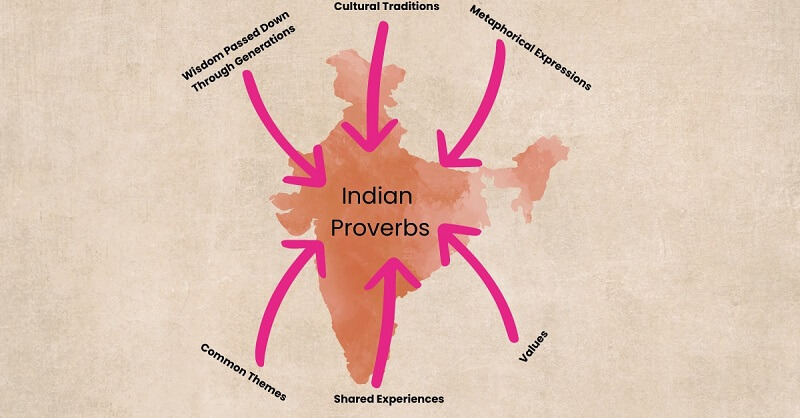Proverbs – Establishing relationship between Indian languages
Proverbs are valuable cultural artefacts that reflect a society’s wisdom, beliefs, and values. In the case of India, a country known for its linguistic diversity, proverbs play a significant role in establishing a relationship between Indian languages. Despite the linguistic differences, there are often similarities and shared themes found in proverbs across various Indian languages, demonstrating the interconnectedness of Indian culture. Let’s explore some examples:
1. Unity in Diversity:
Proverb in Hindi: “वसुधैव कुटुम्बकम्” (Vasudhaiva Kutumbakam)
Translation: “The world is one family.”
Explanation: This proverb emphasises the idea of unity and inclusiveness, highlighting that despite India’s linguistic and cultural diversity, all people are interconnected and should live together harmoniously. This sentiment is echoed in different Indian languages, showcasing the shared value of unity.
2. Importance of Hard Work:
Proverb in Tamil: “செயல்படும் எவன் கண்கலன், அது வெற்றியாகும்” (Seiyalpatum Evan Kangalan, Athu Vettiyagum)
Translation: “Whatever one does with focus will succeed.”
Explanation: This Tamil proverb highlights the significance of diligence and perseverance. Similar sayings emphasising the value of hard work can be found in other Indian languages as well, reflecting the shared cultural emphasis on the importance of dedicated effort.
3. Wisdom and Experience:
Proverb in Bengali: “বয়স যত্নের বই” (Boishya Jatner Boi)
Translation: “Age is the book of carefulness.”
Explanation: This Bengali proverb suggests that with age comes wisdom and experience. The sentiment expressed in this proverb resonates across different Indian languages, illustrating the belief that elders possess valuable knowledge to be cherished and respected.
4. Adaptability and Flexibility:
Proverb in Marathi: “अनुभवांचा अभ्यास उपयोगी” (Anubhavancha Abhyas Upyogi)
Translation: “Experience makes one adaptable.”
Explanation: This Marathi proverb conveys that experience helps individuals become adaptable and flexible. The concept of adaptability is shared across Indian languages, recognising the importance of being open to change and learning from one’s experiences.
5. Perseverance and Patience:
Proverb in Malayalam: “സാഹസത്തിന്റെ ഫലം താഴ്ന്നുപോകുന്നു” (Sahasattinte Phalam Thazhnanupokunnu)
Translation: “The fruit of courage ripens slowly.”
Explanation: This Malayalam proverb emphasises the virtue of patience and perseverance. Similar sayings stressing the importance of patience and waiting for favourable outcomes are found in other Indian languages, illustrating the shared cultural value of resilience.
Let’s explore how proverbs can bridge the linguistic gap and highlight the shared cultural heritage among Indian languages.
Common Themes and Shared Experiences:
Proverbs often revolve around universal themes and shared experiences. While the specific sayings may differ across languages, their underlying messages and moral lessons can be remarkably similar. For example, the Hindi proverb “जैसा देश, वैसा भेष” (As the country, so the attire) and the Tamil proverb “Naduvaanukku naadu” (For the dog, its own country) emphasise the importance of adapting to the cultural norms and customs of a particular place. Such proverbs connect the Hindi and Tamil languages by highlighting the shared value of cultural sensitivity and adaptability.
Metaphorical Expressions:
Proverbs often employ metaphors and figurative language to convey deeper meanings. While the literal translations of proverbs may vary across languages, their metaphorical expressions can create a sense of interconnectedness. For instance, the Bengali proverb “গাছ-ই কাকাতুয়া, ফল-ই কাঠাল” (Gachh-e kakatua, phal-e kathal) (The crow sits on the tree, but the fruit is jackfruit) and the Kannada proverb “ಹುಲ್-ಎ ಚಿಟಿಕೆ, ಹನ್-ಇ ಕಲಿಕೆ”(Hull-e chitike, hann-e kalike) (The bird on the thorn, the pain is for the hand) both communicate the idea that appearances can be deceiving. Such proverbs connect Bengali and Kannada using metaphorical language to express shared wisdom.
Cultural Traditions and Values:
Proverbs often reflect the cultural traditions and values of a community. Although the specific customs may differ, overarching values resonate across Indian languages. For example, the Punjabi proverb “ਆਪਿ ਕਹੀਐ, ਨ ਦੋਸੀ ਕਹੀਐ” (Apani kahiye, na dosi kahiye) (Speak your own words, but do not speak ill of others) and the Malayalam proverb “സ്വന്തം പേസു, പക്ഷേ പറയതേ പേസു” (Swantam pesu, pakshe parayathe pesu) (Speak for yourself, but do not speak about others) both emphasise the importance of respectful communication and avoiding gossip. These proverbs connect Punjabi and Malayalam by highlighting the shared cultural value of maintaining harmonious relationships through speech.
Wisdom Passed Down Through Generations:
Proverbs are often passed down through generations, serving as a repository of ancestral wisdom. While the specific proverbs may differ across languages, the essence of their wisdom connects different Indian languages. For instance, the Gujarati proverb “ગંગા મા ગઈ ભઈસ નદી લે ગઈ”(Ganga ma gayi bhais nadiya le gayi) (Mother Ganges took away the buffalo, but brought back the river) and the Marathi proverb (Go to neher, lakshat gele naadi) (The cow went to the canal, but returned as a river) both convey the idea that even small contributions can lead to significant outcomes. These proverbs establish a connection between Gujarati and Marathi by emphasising the shared belief in the power of individual actions.
In conclusion, proverbs serve as a thread that connects Indian languages by highlighting shared themes, experiences, metaphors, cultural values, and ancestral wisdom. By exploring the rich tapestry of proverbs in different Indian languages, we can deepen our understanding of the interconnectedness and cultural heritage that unites this linguistically diverse nation.
